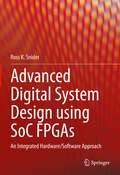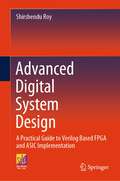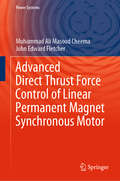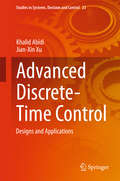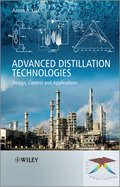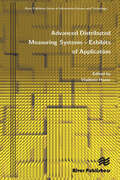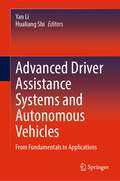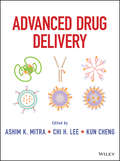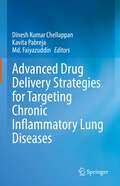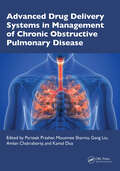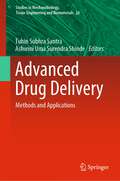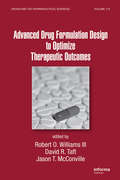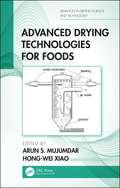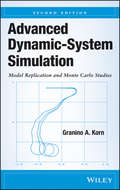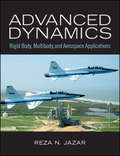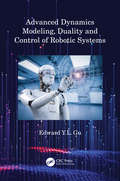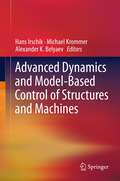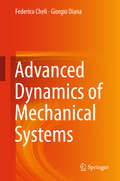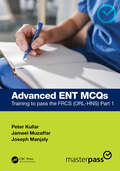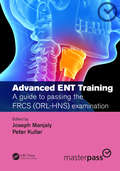- Table View
- List View
Advanced Digital System Design using SoC FPGAs: An Integrated Hardware/Software Approach
by Ross K. SniderThis textbook teaches students techniques for the design of advanced digital systems using System-on-Chip (SoC) Field Programmable Gate Arrays (FPGAs). The author demonstrates design of custom hardware components for the FPGA fabric using VHDL, with implementation of custom hardware-software interfaces. Readers gain hands-on experience by writing programs and Linux device drivers in C to interact with custom hardware. This textbook enables laboratory experience in the design of custom digital systems using SoC FPGAs, emphasizing computational tasks such as digital signal processing, audio, or video processing.
Advanced Digital System Design: A Practical Guide to Verilog Based FPGA and ASIC Implementation
by Shirshendu RoyThe book is designed to serve as a textbook for courses offered to undergraduate and graduate students enrolled in electrical, electronics, and communication engineering. The objective of this book is to help the readers to understand the concepts of digital system design as well as to motivate the students to pursue research in this field. Verilog Hardware Description Language (HDL) is preferred in this book to realize digital architectures. Concepts of Verilog HDL are discussed in a separate chapter and many Verilog codes are given in this book for better understanding. Concepts of system Verilog to realize digital hardware are also discussed in a separate chapter. The book covers basic topics of digital logic design like binary number systems, combinational circuit design, sequential circuit design, and finite state machine (FSM) design. The book also covers some advanced topics on digital arithmetic like design of high-speed adders, multipliers, dividers, square root circuits, and CORDIC block. The readers can learn about FPGA and ASIC implementation steps and issues that arise at the time of implementation. One chapter of the book is dedicated to study the low-power design techniques and another to discuss the concepts of static time analysis (STA) of a digital system. Design and implementation of many digital systems are discussed in detail in a separate chapter. In the last chapter, basics of some advanced FPGA design techniques like partial re-configuration and system on chip (SoC) implementation are discussed. These designs can help the readers to design their architecture. This book can be very helpful to both undergraduate and postgraduate students and researchers.
Advanced Direct Thrust Force Control of Linear Permanent Magnet Synchronous Motor (Power Systems)
by John Edward Fletcher Muhammad Ali CheemaThis book explores the direct thrust force control (DTFC) of tubular surface-mount linear permanent magnet synchronous motors (linear PMSMs). It presents a detailed account and analysis of several advanced nonlinear control schemes, based on the direct thrust control principle, to achieve a reduction in steady-state ripple in thrust force with faster transient response, and describes their experimental validation. It also provides rigorous details of the dynamic modelling of linear PMSMs from a control system perspective, and demonstrates the superior control performance of the proposed techniques compared to the current state-of-the-art techniques. Lastly, the book proposes and validates a stator flux observer for sensorless speed estimation comprising a linear state observer and an improved sliding mode component.
Advanced Discrete-Time Control: Designs and Applications (Studies in Systems, Decision and Control #23)
by Khalid Abidi Jian-Xin XuThis book covers a wide spectrum of systems such as linear and nonlinear multivariable systems as well as control problems such as disturbance, uncertainty and time-delays. The purpose of this book is to provide researchers and practitioners a manual for the design and application of advanced discrete-time controllers. The book presents six different control approaches depending on the type of system and control problem. The first and second approaches are based on Sliding Mode control (SMC) theory and are intended for linear systems with exogenous disturbances. The third and fourth approaches are based on adaptive control theory and are aimed at linear/nonlinear systems with periodically varying parametric uncertainty or systems with input delay. The fifth approach is based on Iterative learning control (ILC) theory and is aimed at uncertain linear/nonlinear systems with repeatable tasks and the final approach is based on fuzzy logic control (FLC) and is intended for highly uncertain systems with heuristic control knowledge. Detailed numerical examples are provided in each chapter to illustrate the design procedure for each control method. A number of practical control applications are also presented to show the problem solving process and effectiveness with the advanced discrete-time control approaches introduced in this book.
Advanced Display Technology: Next Generation Self-Emitting Displays (Series in Display Science and Technology)
by In Byeong Kang Chang Wook Han Jae Kyeong JeongThis book provides a comprehensive and up-to-date guide to the AMOLED technologies and applications which have become industry standard in a range of devices, from small mobile displays to large televisions. Unlike other books on the topic, which cover the fundamentals, materials, processing, and manufacturing of OLEDs, this one-stop book discusses the core components, such as TFT backplanes, OLED materials and devices, and driving schematics together in one volume with chapters written by experts from leading international companies in the field of OLED materials and OLED TVs. It also examines emerging areas, such as micro-LEDs, displays using quantum dots, and AR & VR displays. Presenting the latest research trends as well as the basic principles of each topic, this book is intended for undergraduate and postgraduate students taking display-related courses, new researchers, and engineers in related fields.
Advanced Distillation Technologies
by Anton A. KissDistillation has historically been the main method for separating mixtures in the chemical process industry. However, despite the flexibility and widespread use of distillation processes, they still remain extremely energy inefficient. Increased optimization and novel distillation concepts can deliver substantial benefits, not just in terms of significantly lower energy use, but also in reducing capital investment and improving eco-efficiency. While likely to remain the separation technology of choice for the next few decades, there is no doubt that distillation technologies need to make radical changes in order to meet the demands of the energy-conscious society.Advanced Distillation Technologies: Design, Control and Applications gives a deep and broad insight into integrated separations using non-conventional arrangements, including both current and upcoming process intensification technologies. It includes:Key concepts in distillation technologyPrinciples of design, control, sizing and economics of distillationDividing-wall column (DWC) - design, configurations, optimal operation and energy efficient and advanced controlDWC applications in ternary separations, azeotropic, extractive and reactive distillationHeat integrated distillation column (HIDiC) - design, equipment and configurationsHeat-pump assisted applications (MVR, TVR, AHP, CHRP, TAHP and others)Cyclic distillation technology - concepts, modeling approach, design and control issuesReactive distillation - fundamentals, equipment, applications, feasibility schemeResults of rigorous simulations in Mathworks Matlab & Simulink, Aspen Plus, Dynamics and Custom ModelerContaining abundant examples and industrial case studies, this is a unique resource that tackles the most advanced distillation technologies - all the way from the conceptual design to practical implementation.The author of Advanced Distillation Technologies, Dr. Ir. Anton A. Kiss, has been awarded the Hoogewerff Jongerenprijs 2013. Find out more (website in Dutch)...
Advanced Distributed Measuring Systems - Exhibits of Application
by Prof. Vladimír HaaszMeasuring systems are an essential part of all automated production systems, they also serve to ensure quality of production or they are used to assure the reliability and safety in various areas. The same applies in principle likewise for fields of telecommunication, energy production and distribution, health care etc. Similarly no serious scientific research in the field of natural and technical sciences can be performed without objective data about the investigated object, which are usually acquired using measuring system. Demands on the speed and accuracy of measurement increase in all areas in general. These are the grounds for publishing this book.The book "Advanced distributed measuring systems - exhibits of application" offers 8 up-to-date examples of typical laboratory, industrial and biomedical applications of advanced measuring and information systems including virtual instrumentation. It arose based on the most interesting papers from this area published at IDAACS'2011 conference. However, single chapters include not only system design solution in wider context but also relevant theoretical parts, achieved results and possible future ways of design and development.Technical topics discussed in the book include:• embedded applications;• small distributed systems;• automotive distributed system;• distributed monitoring systems based on wireless networks;• synchronisation in large DAQ systems;• virtual instrumentation."Advanced distributed measuring systems - exhibits of application" is ideal for personnel of firms deals with control systems, automotive electronics, airspace instrumentation, health care technology etc. as well as academic staff and postgraduate students in electrical, control and computer engineering.
Advanced Driver Assistance Systems and Autonomous Vehicles: From Fundamentals to Applications
by Yan Li Hualiang ShiThis book provides a comprehensive reference for both academia and industry on the fundamentals, technology details, and applications of Advanced Driver-Assistance Systems (ADAS) and autonomous driving, an emerging and rapidly growing area. The book written by experts covers the most recent research results and industry progress in the following areas: ADAS system design and test methodologies, advanced materials, modern automotive technologies, artificial intelligence, reliability concerns, and failure analysis in ADAS. Numerous images, tables, and didactic schematics are included throughout. This essential book equips readers with an in-depth understanding of all aspects of ADAS, providing insights into key areas for future research and development. • Provides comprehensive coverage of the state-of-the-art in ADAS • Covers advanced materials, deep learning, quality and reliability concerns, and fault isolation and failure analysis • Discusses ADAS system design and test methodologies, novel automotive technologies • Features contributions from both academic and industry authors, for a complete view of this important technology
Advanced Drug Delivery
by Kun Cheng Chi H. Lee Ashim MitraProvides both fundamentals and new and emerging applications Advanced Drug Delivery brings readers fully up to date with the state of the science, presenting the basics, formulation strategies, and therapeutic applications of advanced drug delivery. The book demonstrates how core concepts of pharmaceutical sciences, chemistry, and molecular biology can be combined and applied in order to spark novel ideas to design and develop advanced drug delivery systems for the treatment of a broad range of human diseases. Advanced Drug Delivery features contributions from an international team of pharmaceutical scientists. Chapters reflect a thorough review and analysis of the literature as well as the authors' firsthand experience developing drug delivery systems. The book is divided into four parts: Part I, Introduction and Basics of Advanced Drug Delivery, explores physiological barriers, stability, transporters, and biomaterials in drug delivery Part II, Strategies for Advanced Drug Delivery, offers tested and proven strategies for advanced delivery of both small molecules and macromolecules Part III, Translational Research of Advanced Drug Delivery, focuses on regulatory considerations and translational applications of advanced drug delivery systems for the treatment of cardiovascular diseases, cancer, sexually transmitted diseases, ophthalmic diseases, and brain diseases Part IV, Future Applications of Advanced Drug Delivery in Emerging Research Areas, examines stem cell research, cell-based therapeutics, tissue engineering, and molecular imaging Each chapter provides objectives and assessment questions to help readers grasp key concepts and assess their knowledge as they progress through the book. Advanced Drug Delivery is recommended for graduates and upper-level undergraduates in the pharmaceutical sciences who need a solid foundation in the basics. It is also recommended for pharmaceutical professionals who want to take advantage of new and emerging applications in advanced drug delivery systems.
Advanced Drug Delivery Strategies for Targeting Chronic Inflammatory Lung Diseases
by Dinesh Kumar Chellappan Kavita Pabreja Md. FaiyazuddinThis book describes the growing clinical and healthcare relevance of nano-therapeutics in treating respiratory diseases. It begins with a brief introduction on the different types of nanoparticles in respiratory disease conditions. It further discusses the current trends in understanding the disease pathology using different in vitro and in vivo models, which are important towards the onsite clinical applications and development of new therapeutics. The book includes exciting topics such as formulation of these nanoparticles, targeting various organelles etc. It also describes the future prospects and challenges in the field. Different chapters are written by researchers actively working in the area of pulmonary diseases. This book is designed to address the requirements of both beginners and specialized scientists involved in pulmonary research. The contents include basic concepts followed by advanced state-of-art monitoring and treatment of diseases. The book is meant for researchers and industry experts in nanotechnology, pharmaceutical sciences and drug design.
Advanced Drug Delivery Systems in Management of Chronic Obstructive Pulmonary Disease
by Gang Liu Kamal Dua Amlan Chakraborty Parteek Prasher Mousmee SharmaThis book offers a comprehensive overview of the epidemiology, etiology, and pathophysiology of chronic obstructive pulmonary disease (COPD). It addresses the limitations of existing drug delivery methods and explores advanced delivery systems to overcome these challenges, providing an exhaustive account of their intricate mechanisms. The introductory chapters elucidate pathways responsible for COPD progression, followed by a detailed analysis of established biomarkers and potential targets in contemporary COPD therapy. Subsequent chapters provide insights into ongoing treatment modalities, their efficacy, drawbacks, and prospective solutions to counter the setbacks of COPD therapy. The subsequent section covers state-of-the-art drug delivery technologies and novel drug formulations designed to enhance drug deposition and absorption in COPD lungs. It further explores a methodical yet coordinated explanation of targeted personalized therapies and emerging approaches, including nanoparticles, polymeric carriers, and vesicular delivery systems. Toward the end, the book discusses ongoing and completed clinical trials encompassing the management of COPD through advanced drug delivery approaches. It serves as a valuable resource for professionals, scientists, academicians, and clinicians specializing in respiratory health. Provides an in-depth understanding of the epidemiology, etiology, and pathophysiology of Chronic Obstructive Pulmonary Disease (COPD) Delve into pathways responsible for COPD progression, conducting a detailed analysis of established biomarkers and potential targets in contemporary COPD therapy Offer insights into ongoing treatment modalities, evaluating their efficacy, drawbacks, and proposing prospective solutions to counter the setbacks of COPD therapy Systematically organizes information on state-of-the-art drug delivery technologies and novel formulations designed to enhance drug deposition and absorption in COPD lungs Presents a methodical explanation of targeted personalized therapies and emerging approaches, including nanoparticles, polymeric carriers, and vesicular delivery systems
Advanced Drug Delivery: Methods and Applications (Studies in Mechanobiology, Tissue Engineering and Biomaterials #26)
by Tuhin Subhra Santra Ashwini Uma Surendra ShindeThis book provides an overview of various drug delivery systems at the cellular level including biological, chemical methods, and most importantly physical methods such as photoporation, electroporation, mechanoporation, and device-based techniques (e.g., microfluidics), as well as organism-level techniques including nanomaterials, biomaterials, and transdermal. Drug delivery (DD) can be defined as the method and route by which an active pharmaceutical ingredient (API) is administered to promote its desired pharmacological effect and/or convenience and/or to reduce adverse effects. Drug delivery systems are developed to maximize drug efficacy and minimize side effects. As drug delivery technologies improve, the drug becomes safer and more comfortable for patients to use. During the last seven decades, extraordinary progress has been made in drug delivery technologies, such as systems for long-term delivery for months and years, localized delivery, and targeted delivery. The advances, however, will face the next phase considering the future technologies that we need to overcome many physicochemical barriers for new formulation development and biological unknowns for treating various diseases. Thus, various technologies are built at a single-cell level as well as an organism level. This book is useful at the university level for graduate courses or research studies and biotechnology-based companies with research and development on cell-based analysis, diagnosis, or drug screening. This book is also very useful for researchers in drug delivery technologies, which came in frontier research for the past decade.
Advanced Drug Formulation Design to Optimize Therapeutic Outcomes (Drugs and the Pharmaceutical Sciences)
by Robert O. Williams III David R. Taft Jason T. McConvilleThis title demonstrates how advanced formulation designs and delivery technologies can be used to improve drug efficacy and treatment outcomes in particular therapeutic categories or disease states. It discusses nanoparticle systems for cancer treatments, and also presents cutting edge immono-regulation agents for transplantation and the local targ
Advanced Drying Technologies
by Arun S. Mujumdar Tadeusz KudraPresents Drying Breakthroughs for an Array of MaterialsDespite being one of the oldest, most energy-intensive unit operations, industrial drying is perhaps the least scrutinized technique at the microscopic level. Yet in the wake of today's global energy crisis, drying research and development is on the rise. Following in the footsteps of the widel
Advanced Drying Technologies for Foods (Advances in Drying Science and Technology)
by Arun S. Mujumdar Hong-Wei XiaoThe goal of all drying research and development is to develop cost-effective innovative processes that yield high-quality dried products with less energy consumption and reduced environmental impact. With the literature on drying widely scattered, Advanced Drying Technologies for Foods compiles under one cover concise, authoritative, up-to-date assessments of modern drying technologies applied to foods. This book assembles a number of internationally recognized experts to provide critical reviews of advanced drying technologies, their merits and limitations, application areas and research opportunities for further development. Features: Provides critical reviews of advanced drying technologies Discusses the merits and limitations of a variety of food drying technologies Explains drying kinetics, energy consumption and quality of food products Reviews the principles and recent applications of superheated steam drying The first four chapters deal with recent developments in field-assisted drying technologies. These include drying techniques with the utilization of electromagnetic fields to deliver energy required for drying, for example, microwave drying, radio frequency drying, electrohydrodynamic drying, and infrared radiation drying. The remainder of this book covers a wide assortment of recently developed technologies, which include pulse drying, swell drying, impinging stream drying, and selected advances in spray drying. The final chapter includes some innovative technologies which are gaining ground and are covered in depth in a number of review articles and handbooks, and hence covered briefly in the interest completeness. This book is a valuable reference work for researchers in academia as well as industry and will encourage further research and development and innovations in food drying technologies.
Advanced Dungeons & Dragons Players Handbook
by E. Gary GygaxA COMPILED VOLUME OF INFORMATION FOR PLAYERS OF ADVANCED DUNGEONS & DRAGONS, INCLUDING: CHARACTER RACES, CLASSES, AND LEVEL ABILITIES; SPELL TABLES AND DESCRIPTIONS; EQUIPMENT COSTS; WEAPONS DATA; AND INFORMATION ON ADVENTURING.
Advanced Dynamic-System Simulation: Model Replication and Monte Carlo Studies
by Granino A. KornA unique, hands-on guide to interactive modeling and simulation of engineering systems This book describes advanced, cutting-edge techniques for dynamic system simulation using the DESIRE modeling/simulation software package. It offers detailed guidance on how to implement the software, providing scientists and engineers with powerful tools for creating simulation scenarios and experiments for such dynamic systems as aerospace vehicles, control systems, or biological systems. Along with two new chapters on neural networks, Advanced Dynamic-System Simulation, Second Edition revamps and updates all the material, clarifying explanations and adding many new examples. A bundled CD contains an industrial-strength version of OPEN DESIRE as well as hundreds of program examples that readers can use in their own experiments. The only book on the market to demonstrate model replication and Monte Carlo simulation of real-world engineering systems, this volume: Presents a newly revised systematic procedure for difference-equation modeling Covers runtime vector compilation for fast model replication on a personal computer Discusses parameter-influence studies, introducing very fast vectorized statistics computation Highlights Monte Carlo studies of the effects of noise and manufacturing tolerances for control-system modeling Demonstrates fast, compact vector models of neural networks for control engineering Features vectorized programs for fuzzy-set controllers, partial differential equations, and agro-ecological modeling Advanced Dynamic-System Simulation, Second Edition is a truly useful resource for researchers and design engineers in control and aerospace engineering, ecology, and agricultural planning. It is also an excellent guide for students using DESIRE.
Advanced Dynamics
by Reza N. JazarAccording to the author and reviewers, more than 50% of the material taught in courses such as Advanced Dynamics, Mutibody Dynamics, and Spacecraft Dynamics is common to one another. Where graduate students in Mechanical and Aerospace Engineering may have the potential to work on projects that are related to any of the engineering disciplines, they have not been exposed to enough applications in both areas for them to use this information in the real world. This book bridges the gap between rigid body, multibody, and spacecraft dynamics for graduate students and specialists in mechanical and aerospace engineering. The engineers and graduate students who read this book will be able to apply their knowledge to a wide range of applications across different engineering disciplines. The book begins with a review on coordinate systems and particle dynamics which will teach coordinate frames. The transformation and rotation theory along with the differentiation theory in different coordinate frames will provides the required background to learn the rigid body dynamics based on Newton-Euler principles. Applications to this coverage can be found in vehicle dynamics, spacecraft dynamics, aircraft dynamics, robot dynamics, and multibody dynamics, each in a chapter. The Newton equations of motion will be transformed to Lagrange equation as a bridge to analytical dynamics. The methods of Lagrange and Hamilton will be applied on rigid body dynamics. Finally through the coverage of special applications this text provides understanding of advanced systems without restricting itself to a particular discipline. The author will provide a detailed solutions manual and powerpoint slides as ancillaries to this book.
Advanced Dynamics Modeling, Duality and Control of Robotic Systems
by Edward Y.L. GuThis book provides detailed fundamental theoretical reviews and preparations necessary for developing advanced dynamics modeling and control strategies for various types of robotic systems. This research book specifically addresses and discusses the uniqueness issue of representing orientation or rotation, and further proposes an innovative isometric embedding approach. The novel approach can not only reduce the dynamic formulation for robotic systems into a compact form, but it also offers a new way to realize the orientational trajectory-tracking control procedures. In addition, the book gives a comprehensive introduction to fundamentals of mathematics and physics that are required for modeling robot dynamics and developing effective control algorithms. Many computer simulations and realistic 3D animations to verify the new theories and algorithms are included in the book as well. It also presents and discusses the principle of duality involved in robot kinematics, statics, and dynamics. The duality principle can guide the dynamics modeling and analysis into a right direction for a variety of robotic systems in different types from open serial-chain to closed parallel-chain mechanisms. It intends to serve as a diversified research reference to a wide range of audience, including undergraduate juniors and seniors, graduate students, researchers, and engineers interested in the areas of robotics, control and applications.
Advanced Dynamics and Model-Based Control of Structures and Machines
by Alexander K. Belyaev Michael Krommer Hans IrschikThe book contains 26 scientific contributions by leading experts from Russia, Austria, Italy, Japan and Taiwan. It presents an overview on recent developments in Advanced Dynamics and Model Based Control of Structures and Machines. Main topics are nonlinear control of structures and systems, sensing and actuation, active and passive damping, nano- and micromechanics, vibrations and waves.
Advanced Dynamics of Mechanical Systems
by Federico Cheli Giorgio DianaThis book introduces a general approach for schematization of mechanical systems with rigid and deformable bodies. It proposes a systems approach to reproduce the interaction of the mechanical system with different force fields such as those due to the action of fluids or contact forces between bodies, i. e. , with forces dependent on the system states, introducing the concepts of the stability of motion. In the first part of the text mechanical systems with one or more degrees of freedom with large motion and subsequently perturbed in the neighborhood of the steady state position are analyzed. Both discrete and continuous systems (modal approach, finite elements) are analyzed. The second part is devoted to the study of mechanical systems subject to force fields, the rotor dynamics, techniques of experimental identification of the parameters and random excitations. The book will be especially valuable for students of engineering courses in Mechanical Systems, Aerospace, Automation and Energy but will also be useful for professionals. The book is made accessible to the widest possible audience by numerous, solved examples and diagrams that apply the principles to real engineering applications.
Advanced ENT MCQs: Training to pass the FRCS (ORL-HNS) Part 1 (MasterPass)
by Joseph Manjaly Peter Kullar Jameel MuzaffarProviding over 400 high quality MCQs in the style of the Part 1 FRCS (ORL-HNS) together with clear explanations of not only the correct answer but also a structured way of approaching questions, this revision guide enables exam candidates to prepare for the FRCS (ORL-HNS) Section 1 exam with confidence.The questions and answers reflect the new approach to the exam and its focus on higher order judgement and testing real world clinical decision making. Questions are presented as a common stem with five possible answers, one of which will be the most correct answer: a ‘single best answer’. The stem is carefully written, so that every word should help guide candidates to the correct answer. None of the answers will be obviously wrong or dangerous. The candidate must recognise that a ‘single best answer’ is not the same as a ‘single correct answer’. In many of the questions, all the presented answers could be considered correct, but the candidate must choose the best or most appropriate answer from those available.Written by an expert author team who have provided valuable insights and expert content to ensure the book’s authority. The content is suitable for exam candidates from the UK and for International ENT trainees preparing to sit the FRCS (ORL-HNS) exam. It is also applicable for candidates preparing for the DOHNS/MRCS ENT exam.
Advanced ENT training: A guide to passing the FRCS (ORL-HNS) examination
by Joseph Manjaly Peter KullarThe syllabus for the FRCS (ORL-HNS) is vast and sound preparation for the exams has traditionally involved assimilatiing knowledge from a wide range of sources. This book provides a focussed guide for exam candidates. More than a question and answer book, this book is a coaching manual. Each section features a combination of model answers, pearls of wisdom, checklists and pointers for further reading. Detailed advice is provided for both Part 1 and Part 2 of the examnation. Viva topics that have featured in the exam in recent years have been included. and have then been supplemented by invaluable editorial contributions from leaders in each of the subspecialties. Trainees frequently comment that exam preparation is an enlightening process and the knowledge gained would have served them well during their time as an ENT registrar or Otorhinolaryngology resident.This book will also serve as a valuable learning tool for trainees as early as ST3 and facilitate their development of effective and safe clinical practice.
Advanced ERCP for Complicated and Refractory Biliary and Pancreatic Diseases
by Dong Ki LeeThis book provides a comprehensive overview of non-surgical treatments for complicated and refractory biliary and pancreatic lesions. In particular, it offers non-surgical treatment options for benign biliary strictures. For those suffering from intractable total biliary obstruction following biliary operation, magnetic compression anastomosis represents a good therapeutic option, and this technique is fully explained. Moreover, the book describes diverse treatment modalities for hilar stricture, which is one of the most challenging areas of ERCP. Several chapters cover a variety of important aspects of this area. The book also aims to identify and solve the unmet needs for the diagnosis and treatment of biliary and pancreatic diseases. The precise explanations of treatment concepts and strategies will both increase readers’ knowledge and provide assistance in daily clinical practice. The authors are pioneering experts from around the world, and the text is supported by numerous informative illustrations and helpful summaries.
